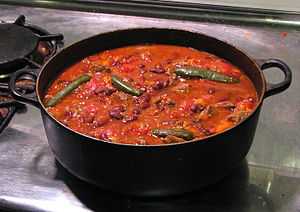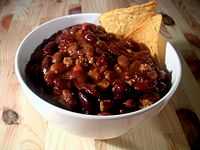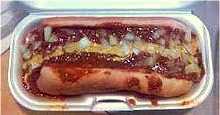Chili con carne
| Chili con carne | |
|---|---|
| Main | |
 A pot of chili con carne with whole green hot chiles, kidney beans and tomatoes. | |
| Alternative name(s): | |
| Chili | |
| Place of origin: | |
| United States | |
| Region or state: | |
| Texas | |
| Serving temperature: | |
| Hot | |
| Main ingredient(s): | |
| Chili peppers, meat, tomatoes, often made with beans | |
| Variations: | |
| Multiple | |
| Recipes at Wikibooks: | |
|
| |
| Media at Wikimedia Commons: | |
|
|
Chili con carne (“chili with meat”), more commonly known in American English as simply “chili”, is a spicy stew containing chili peppers, meat (usually beef), tomatoes and often beans. Other seasonings may include garlic, onions, and cumin. Variations, both geographic and personal, may involve different types of meat, as well as a variety of other ingredients. The variant recipes provoke disputes among aficionados, some of whom insist that the word “chili” applies only to the basic dish. Chili is a frequent dish for cook-offs. It is also used as an ingredient in a number of other dishes.
Origins and history
In Spanish, the word chili refers to a “chili pepper”, and carne means “meat”.
The recipe used by American frontier settlers consisted of dried beef, suet, dried chili peppers and salt, which were pounded together, formed into bricks and left to dry, which could then be boiled in pots on the trail.[citation needed]
The San Antonio Chili Stand, in operation at the 1893 Columbian Exposition in Chicago, helped people from other parts of the United States taste and appreciate chili. San Antonio was a significant tourist destination and helped Texas-style chili con carne spread throughout the South and West.[1] Chili con carne is the official dish of the U.S. state of Texas as designated by the House Concurrent Resolution Number 18 of the 65th Texas Legislature during its regular session in 1977.[2]
Chili queens
During the 1880s, brightly dressed Mexican American women known as “chili queens” began to operate around Military Plaza and other public gathering places in downtown San Antonio. They appeared at dusk, when they built charcoal or wood fires to reheat cauldrons of pre-cooked chili. They sold it by the bowl to passersby. The aroma was a potent sales pitch; mariachi street musicians joined in to serenade the eaters. Some chili queens later built semi-permanent stalls in the mercado (local Hispanic market).
In September 1937, the San Antonio Health Department implemented new sanitary regulations that required the chili queens to adhere to the same standards as indoor restaurants. Unable to provide lavatory facilities, the queens and their “street chili” culture disappeared overnight. Although Mayor Maury Maverick reinstated the queens’ privileges in 1939, the city reapplied the more stringent regulations permanently in 1943.
San Antonio’s mercado was renovated in the 1970s, at which time it was the largest Mexican marketplace in the U.S. Local merchants began staging historic re-enactments of the chili queens’ heyday. The unofficial re-enactment is, "Return of the Chili Queens Festival".
Since 2006, the historic Bonham Exchange Building, located behind the Alamo, has hosted the official Chili Queens event, which is held in April as the first Sunday of every Fiesta.
Chili parlors
Before World War II, hundreds of small, family-run chili parlors (also known as “chili joints”) could be found throughout Texas and other states, particularly those in which émigré Texans had made new homes. Each establishment usually had a claim to some kind of secret recipe.

As early as 1904, chili parlors were opening outside of Texas. After working at the Louisiana Purchase Exposition, Charles Taylor opened a chili parlor in Carlinville, Illinois, serving "Mexican Chili".[3] In the 1920s and 1930s chains of diner-style "chili parlors" grew up in the Midwest. As of 2005, one of these old-fashioned chili parlors still existed on Pine Street in downtown St. Louis. It features a chili-topped dish called a "slinger": two cheeseburger patties, hash browns, and two eggs, and smothered in chili.[4]
One of the best-known Texas chili parlors, in part because of its downtown location and socially connected clientele, was Bob Pool's "joint" in Dallas, just across the street from the headquarters of the elite department store Neiman Marcus. Stanley Marcus, president of the store, frequently ate there. He also bought Pool's chili to send by air express to friends and customers across the country. Several members of General Dwight Eisenhower's SHAPE staff during the early 1950s were reported to have arranged regular shipments of chili from Pool's to their Paris quarters.
Controversy over ingredients

Beans
Beans, a staple of Tex-Mex cuisine, have been associated with chili as far back as the early 20th century.[5] The question of whether beans "belong" in chili has been a matter of contention among chili cooks for a long time.

Texas-style chili does not contain beans and may even be made with no other vegetables whatsoever besides chili peppers.[6] President Lyndon B. Johnson's favorite chili recipe became known as "Pedernales River chili" after the location of his Texas Hill Country ranch. It calls for eliminating the traditional beef suet (on Johnson's doctor's orders, after Johnson suffered a heart attack while he was Senate Majority Leader) and adds tomatoes and onions. Johnson preferred venison, when available, to beef, as Hill Country deer are leaner than most beef.[7] Lady Bird Johnson, the First Lady, had the recipe printed on cards to be mailed out because of the many thousands of requests the White House received for it.[8]
In some areas, specifically the American South, versions with beans are referred to as "chili beans" while the term "chili" is reserved for the all-meat dish. Small red beans are commonly used for chili, as are black-eyed peas, kidney beans, great northern beans, or navy beans. Chili bean can refer to a small red variety of common bean also known as the pink bean. The name may have arisen from that bean's resemblance to small chili peppers, or it may be a reference to that bean's inclusion in chili recipes.
Most commercially prepared canned chili includes beans. Commercial chili prepared without beans is usually called "chili no beans" in the United States. Some U.S. manufacturers, notably Bush Brothers and Company and Eden Organic, also sell canned precooked beans (with no meat) that are labeled "chili beans"; these beans are intended for consumers to add to a chili recipe and are often sold with spices added.
Evidence suggests that there is nothing inauthentic about the inclusion of beans.[9] Despite this, the Chili Appreciation Society International specified in 1999 that, among other things, cooks are forbidden to include beans in the preparation of chili for official competition—nor are they allowed to marinate any meats.[10]
Tomatoes
Tomatoes are another ingredient on which opinions differ. Wick Fowler, north Texas newspaperman and inventor of "Two-Alarm Chili" (which he later marketed as a "kit" of spices), insisted on adding tomato sauce to his chili — one 15-oz. can per three pounds of meat. He also believed that chili should never be eaten freshly cooked but refrigerated overnight to seal in the flavor. Matt Weinstock, a Los Angeles newspaper columnist, once remarked that Fowler's chili "was reputed to open eighteen sinus cavities unknown to the medical profession."[11]
Variations
Vegetarian chili

Vegetarian chili (also known as chili sin carne, chili without meat, chili non carne, and chili sans carne) acquired wide popularity in the U.S. during the 1960s and 1970s with the rise of vegetarianism. It is also popular with those on a diet restricting the use of red meat. To make the chili vegetarian, the cook leaves out the meat or replaces it with a meat analogue, such as textured vegetable protein or tofu, or a starchy vegetable, such as potatoes. These chilis nearly always include beans. Variants may contain corn, squash, mushrooms, or beets.
Chili verde
Chili verde (green chili) is a moderately to extremely spicy Mexican-American stew or sauce usually made from chunks of pork that have been slow-cooked in chicken broth, garlic, tomatillos, and roasted green chilis. Tomatoes are rarely used. The spiciness of the chili is adjusted with poblano, jalapeño, serrano, and occasionally habanero peppers. Chili verde is a common filling for the Mission burrito.
White chili
White chili is made using white beans and turkey meat or chicken breast instead of a tomato-based sauce and red meat (beef). The resulting dish appears white when cooked.
Accompaniments and additions
The dish may be served with toppings or accompaniments; grated cheese, diced onions, and sour cream are common toppings, as are broken saltine crackers, corn chips, cornbread, rolled-up corn or flour tortillas, and pork tamales. Chili can also be served over rice or pasta such as ditalini or spaghetti.
Pre-made chili
Canned chili
Willie Gebhardt, originally of New Braunfels, Texas, and later of San Antonio, produced the first canned chili in 1908. Rancher Lyman Davis near Corsicana, Texas, developed Wolf Brand Chili in 1885. He owned a meat market and was a particular fan of Texas-style chili. In the 1880s, in partnership with an experienced range cook, he began producing heavily spiced chili based on chunks of lean beef and rendered beef suet, which he sold by the pot to local cafés. In 1921, Davis began canning his product, naming it for his pet wolf "Kaiser Bill". Wolf Brand canned chili was a favorite of Will Rogers, who always took along a case when traveling and performing in other regions of the world. Ernest Tubb, the country singer, was such a fan that one Texas hotel maintained a supply of Wolf Brand for his visits. Both the Gebhardt and Wolf brands are now owned by ConAgra Foods, Inc. Hormel, which sell chili available with or without beans, made with turkey or in vegetarian varieties, under their own name and other brands like Stagg, is another major maker of canned chili.
Brick chili
Another method of marketing commercial chili in the days before widespread home refrigerators was "brick chili". It was produced by pressing out nearly all of the moisture, leaving a solid substance roughly the size and shape of a half-brick. Wolf Brand was originally sold in this form.[12] Commonly available in small towns and rural areas of the American Southwest in the first three-quarters of the 20th century, brick chili has mostly outlived its usefulness but can still be found in some stores.
Seasoning mix
Home cooks may also purchase seasoning mixes for chili, including packets of dry ingredients such as chili powder, masa flour, salt, and cayenne pepper, to flavor meat and other ingredients.
Other dishes made with chili


- A chili dog is a hot dog served with a topping of chili (usually without beans).
- A chili burger is a burger topped with chili (usually without beans). In California, this is sometimes referred to as a "chili size." Chili is also served on top of a ground beef patty alone.
- Chili is also added to fries and cheese to make chili cheese fries, or Coney Island fries.
- In southeast Texas, some people eat chili served over white rice. Chili over rice (frequently with beans) is also common in Hawaii (where it is known as chili rice) and is eaten this way in the UK and, to some extent, Australia.
- Chili mac is a dish made with canned chili, or roughly the same ingredients as chili (meat, spices, onion, tomato sauce, beans, and sometimes other vegetables), with the addition of macaroni or some other pasta. Chili mac is a standard dish in the U.S. military and is one of the varieties of Meal, Ready-to-Eat (MRE).
- Cincinnati chili is a variety of chili frequently served over spaghetti and on fries and cheese coneys.
- A "Frito pie" typically consists of a small, single-serving bag of Fritos corn chips with a cup of chili poured over the top, usually finished up with grated cheese or onions and jalapeños and sour cream.[13] Frito pies are popular in the southwestern United States.
- A chili stuffed baked potato is a large baked potato stuffed with chili and possibly with other ingredients, such as butter, Cheddar cheese, or chopped onions.
- Chili Poutine substitutes chili con carne for the usual gravy.
See also
Notes
- ↑ "History of Chili, Chili Con Carne". whatscookingamerica.net. 2004. Retrieved 2008-01-06.
- ↑ "State Dish - Chili." Texas State Library and Archives Commission. Retrieved on March 7, 2010.
- ↑ "The First 100 Years", Taylorschili.com
- ↑ O.T. Hodges Menu, a "chili parlor" in Ferguson, MO in business since 1904.
- ↑ Hill, Janet M. (June 1906). Chili Con Carne XI. Boston Cooking-School Magazine. pp. 400, 401.
- ↑ International Chili Society, Official History of Chili October 1, 1999
- ↑ Aidoo, Kofi E.; Haworth, Richard J. P. (1995). "Nutritional and chemical composition of farmed venison". Journal of Human Nutrition and Dietetics 8 (6): 441–6. doi:10.1111/j.1365-277X.1995.tb00339.x.
- ↑ "Chili recipe", LBJ Library, University of Texas
- ↑ Albala, Ken. Beans: A History. Oxford:Berg, 2007 p. 178
- ↑ Chili Appreciation Society International, Official CASI Rules & Guidelines October 1, 1999
- ↑ Tolbert, A Bowl of Red
- ↑ Tommy W. Stringer, "WOLF BRAND CHILI," Handbook of Texas Online (http://www.tshaonline.org/handbook/online/articles/diw01), accessed March 06, 2013. Published by the Texas State Historical Association.
- ↑ "Austin City Limits Festival Food Rocks!". Slashfood. 2007. Retrieved 2007-09-27.
References
- Frank X. Tolbert. A Bowl of Red: A Natural History of Chili con Carne. Garden City, N.Y.: Doubleday, 1966. [Much of the material in this book originally appeared in the author's newspaper columns in The Dallas Morning News beginning in the early 1950s.]
- Charles Ramsdell. San Antonio: An Historical and Pictorial Guide. Austin: University of Texas Press, 1959.
- Joe E. Cooper. With or Without Beans. Dallas: W. S. Henson, 1952.
- H. Allen Smith. "Nobody Knows More About Chili Than I Do." Reprinted at the International Chili Society web site.
- Jack Arnold. The Chili Lover's Handbook. Privately published, 1977.
- Robb Walsh. The Tex-Mex Cookbook: A History in Recipes and Photos. New York: Broadway Books, 2004. [A very knowledgeable and very well-written "food history", including a long chapter on "real" chili, chili joints, and the San Antonio chili queens.]
- Fr. Michael Muller. The Catholic Dogma, 1888
External links
| Wikimedia Commons has media related to: |
| Wikibooks Cookbook has a recipe/module on |
